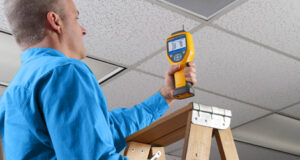Mold Removal Process Chambly
Mold inspections must be done very enough if you suspect mold growth since some types of mold can seriously threaten the health of you and your family. Although you may buy DIY mold kits and do the test, experts advise getting in touch with qualified mold specialists for mold inspections. Mold contamination may be to blame if you’ve seen mold symptoms like discolored walls, stains on your ceiling, or a musty odor. If black mold is not removed right away, it can readily spread. We are a registered and insured mold firm offering services for black mold removal, mold testing, inspections, and testing for mold in residential and commercial settings. We offer transferrable certificates for mold remediation on homes to new homeowners in Chambly along with our free mold inspection services.
During a mold inspection, we evaluate the damaged regions, determine the mold’s source, and find any further locations that might be affected by mold or moisture problems. Mold will continue to grow and spread to unaffected places unless the source of the growth is found and additional areas that may contain mold are examined. After conducting a mold inspection, our trained project manager will create a thorough scope of work report that includes our conclusions, suggestions, a plan for remediation, and a cost estimate. We also go over several approaches and ways to stop mold from coming back in Chambly.

The Importance of Mold Inspection
Air testing is done to determine whether invisible mold is present in the home and how far it has spread. Mold spores are microscopic particles that are invisible to the unaided eye that travels through the air until they reach conditions favorable for growth, such as damp or dark locations with moist surfaces. When mold is developing in low-traffic locations like the attic, behind the walls, or in the corners of the basement, it can take some time before you even detect the presence of the spores. Mold testing can assess the quality of your indoor air, discover hidden mold, and determine the type of mold present so that the right repair may be carried out.
If the mold is ignored or left untreated for a while, it could result in more serious harm to your goods, property, and health. Therefore, experienced remediation specialists should give top importance to mold investigation and removal.
Testing for Mold in Chambly
Mold can occasionally be invisible, so a mold test is necessary to detect its existence. To determine the amount of mold and the mold spore count in the affected region, an air quality test is carried out within your residential or commercial premises. Several air samples will be collected by a qualified professional, who will then transmit them to a recognized laboratory.
The samples will undergo analysis in the lab to ascertain:
- Whether there is mold, and if so, how much
- The kind of mold that is there
A mold report will be provided to you with an explanation of the findings. The report applies to both judicial proceedings and real estate deals.
Mold Removal Process
A methodical strategy is essential for mold removal in Chambly that is both effective and secure. Experienced specialists will customize mold inspections in Chambly to your area, but they will adhere to industry standards and governmental regulations to guarantee full treatment.
Chambly Mold Inspections: Examine the entire building, look for mold-friendly areas, and determine the extent and cause of any outbreaks. Here, mold removal experts can also assist in determining the specific circumstances that led to the mold outbreak.
Mold testing Chambly: Samples are safely gathered using protective equipment and forwarded to reputable, third-party laboratories for unbiased examination. Third-party testing will produce prompt, accurate data that will guide specialists’ mold treatment procedures.
Chambly professionals will begin removing mold utilizing cutting-edge equipment as soon as the extent of the infestation is well recognized. Testing of the air quality will be done after removal to confirm that the damaged areas and property are safe to reoccupy and that the remediation was successful.
Mold Warning Signs near Your Property
Smells of the HVAC system Musty: The main sources of mold growth in homes are heating and air conditioning systems. A Chambly HVAC mold removal specialist can check your heating and cooling systems for any dampness or mold growth and offer assistance in resolving the problem.
Dark Stains in Your Shower Grouts: In Chambly, bathroom mold and grout are frequently caused by moisture and insufficient ventilation. Other causes of bathroom mold removal can include a bathroom plumbing leak or water buildup in the adjacent room. But only Toronto-area mold removal specialists should deal with this dangerous fungus.
Wallpaper peeling: Natural yellowing of wallpaper over time is normal, but peeling or cracking are indications of moisture and humidity in the wall. Mold removal services in Chambly will be necessary to completely repair the decay caused by the mold that infests drywall and wood.
Humidifier: Whether you frequently use one, you may want to see if the moisture is building up and causing any mold growth on porous surfaces like walls, window sills, etc. A hydrometer makes it possible to adjust humidity levels indoors to avoid the growth of mold.
Prevention and Control of Mold
Even if you’ve tried a DIY remediation method and it seems to have worked, the chance of recurring infestations is increased without expert mold removal in Chambly. By reducing moisture and managing contributory factors, a mold epidemic can be stopped. Attics, crawl spaces, walls, and basements with moist environments, leaks, and inadequate drainage are where mold outbreaks are most likely to occur and where the most thorough mold removal services in Chambly are needed.
For efficient mold control and prevention, we highly advise routine inspections.
Verify for:
- Flooding, leaks, or water damage
- Adequate ventilation
- Obstructions or damaged exhaust vents
- Ill-aimed water
